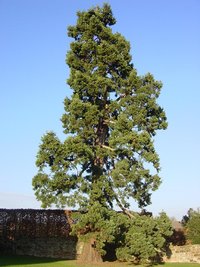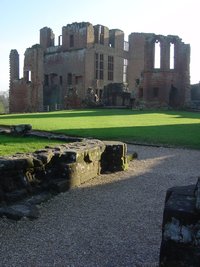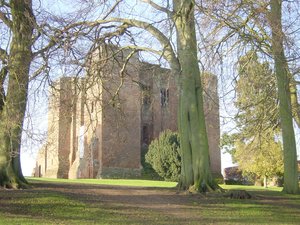Kenilworth Castle
|
|
Kenilworth Castle is in Kenilworth, Warwickshire, England. Historically the Castle was contained within the Forest of Arden.
A fortification has existed on the site from Saxon times. But the current ruin is of Norman origin, a great square stone tower was built by Geoffrey de Clinton, Treasurer and Chief Justice of England to Henry I, in about 1125. Henry II took control of the castle during the rebellion of 1173-1174, giving the Clintons another castle in Buckinghamshire by way of compensation.
Henry II began work on improving the defensive qualities of the castle. Work continued during the reign of Henry III which turned the castle into one of the strongest in the Midlands. The properties of water defences had long been known but at Kenilworth a great lake was created to defend three sides of the castle. Covering over 100 acres (0.4 km²) it was an expensive endeavour, but the value in keeping siege engines further away and as a barrier to assault or mining was immense.
However after all the work to improve the castle Henry III gifted it in 1244 to Simon de Montfort, Earl of Leicester. Simon de Montfort became a leader in the Barons' War (1263-1267) against Henry III, Kenilworth was the centre of his operations and Lord Edward, Henry's heir, was briefly imprisoned at Kenilworth before escaping. De Montfort was killed in battle near Evesham on August 4 1265 facing Lord Edward. In 1266, the rebels under the leadership of Henry de Hastings, used the castle as a refuge when Lord Edward surrounded Kenilworth. The siege of Kenilworth Castle in 1266 is the longest in English history at almost a year. The extensive water defences proved their worth, despite Edward targeting the weaker north wall, defended by only a double moat, employing huge siege towers and even attempting a night attack by barge. The siege was ended on easy terms for the defenders with the Dictum of Kenilworth. The experience gained in water defenses at Kenilworth was put to good effect at later castles built in Wales, notably Caerphilly.
Edward I bestowed the castle upon his youngest son Edmund Crouchback. The castle was inherited by his grandson Henry of Grosmont, 1st Duke of Lancaster, which then passed to his son-in-law John of Gaunt.
From 1364 John of Gaunt began the castle's conversion from a pure fortress into something more liveable, work that continued with his grandson, Henry V. The castle remained in royal hands until it was given to John Dudley in 1553, following his execution Elizabeth I gave it to her favourite Robert Dudley, Earl of Leicester in 1563. Dudley further transformed the castle to suit the tastes of Elizabeth, adding the Leicester building, a large apartment and a residential block overlooking the lake. Elizabeth was expensively and lavishly entertained at Kenilworth for a month in 1575. The castle returned to the Crown on Dudley's death.

In 1600 Charles II gave the castle to Sir Edward Hyde, whom he created Baron Kenilworth and Earl of Clarendon. The great water defences were destroyed in 1656. The castle remained the property of the Clarendons until 1937 before passing into the possession of Sir John Siddeley, later Lord Kenilworth. The family presented the castle to Kenilworth in 1958 and English Heritage has looked after it since 1984.
In 2005 English Heritage announced that after archaeological investigations revealed more details of the original garden, it will be restoring the garden more closely to its Elizabethan form. A fountain and aviary will be reconstructed. The project is scheduled for completion in 2007 [1] (http://www.telegraph.co.uk/news/main.jhtml;sessionid=VJSFMK40RVYAPQFIQMFSM5OAVCBQ0JVC?xml=/news/2005/05/18/ugarden.xml&sSheet=/portal/2005/05/18/ixportaltop.html)
References
Christopher Candy, For the Sake of a Keep: The Siege of Kenilworth, 1267 (http://www.cusd.claremont.edu/~ccandy/his/kenil.html)
External link
- Page on English Heritage's website (http://www.english-heritage.org.uk/default.asp?wci=mainframe&URL1=default.asp%3FWCI%3DNode%26WCE%3D107)



